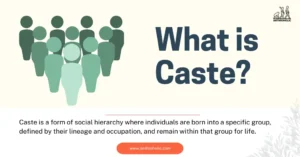AI Answer Evaluation Platform Live Now. Try Free Answer Evaluation Now
Levirate
Marriage is an important social institution without which a society cannot survive and continue. Every society follows certain rules to cover the sex relations and procreation of children, but these vary from culture to culture (Mair, 1965). These sex relations must have social authorization which is given by the marriage institution. Levirate marriage is a tool under preferential marriage1.
The name “Levirate” comes from the Latin word “levir,” which implies a husband’s brother. (Mair, 1965).
A Levirate marriage is one in which the deceased person’s brother is required to wed his brother’s widow. In easier terms, it is marrying the deceased husband’s brother. The brother may be the biological sibling or socially accredited person of the deceased.

Arguments for Levirate Marriage
- It acts as a safeguard for the widow and her children.
- This type of marriage is mainly associated with the patriarchal system.
- To prevent the return of the bride price.
- It ensures permanent relationship and inter – familial cordiality (Majumdar and Madan, 1986)
- Patrilineage controls the belongings and land holdings of the widow (Doshi and Jain, 2001)
Types of Levirate Marriage
1. Junior Levirate
If the woman marries the younger brother of the deceased husband, it is termed as junior levirate.
2. Senior Levirate
If the woman marries the elder brother of the deceased husband, it is termed as senior levirate.
Levi-Strauss explains that these preferential marriages strengthen the solidarity/ harmony within a tribe.
Ember, 2015
In certain tribes, if a man died without any issue, the widow marries the brother of the deceased in order to provide an heir. The first son born from this relationship is regarded as the deceased man’s legitimate heir. Ex. – Ghost marriage in Nuer Tribe.
Levirate Marriage in different cultures
Judaism
- Called as yibbum in the Hebrew Bible.
- Under this the brother of the deceased is motivated to marry the widow.
Islam
- Islamic law, Sharia, mentions the rules of marriage.
- One can marry their brother’s widow and it will be accepted as a normal marriage with the consent of wife and mahr.
India
- Practised among several tribes like – Munda, Gond, Toda, Santhal, etc.
- It is locally termed as devar vivah.
Indonesia
- Karo people of Indonesia practice levirate marriages.
Kurds
- Kurds in Türkiye practice levirate where the widow lives with the husband’s family and if her children are young she has to get married to her deceased husband’s brother.
Africa
- In Nigeria, a widow has to marry husband’s brother if she has children. This aids in the protection of family identity and inheritance.
- This kind of union is practised among the Dinka and Nuer2 tribes of South Sudan.
- Shona people of Zimbabwe follow levirate with bride price called roora.
Conclusion
The Levirate marriage provides an opportunity for the widow to get support both emotionally as well as physically. It helps in carrying the family name. With the increased modernization these practices may have been changed in accordance with the global world.
Definitions
- Preferential Marriage – It is a marriage custom where certain men and women are given preference for the establishment of matrimonial alliance. Like, cross – cousin marriage and parallel – cousin marriage
- The Nuer practice Ghost marriage which is an alternate form of Levirate marriage.
See Also
References
1. Doshi S.L, Jain P.C. (2001). Social Anthropology. Rawat Publications; Jaipur, 2019.
2. Ember Carol, Ember Melvin, Peregrine Peter. (2015). Anthropology. Pearson Education; Noida, 2019.
3. Levirate. https://www.britannica.com/topic/levirate . Accessed on 15 February 2023.
4. Levirate, Sororate, Ghost Marriage and More. https://laulima.hawaii.edu/access/content/user/millerg/ANTH_200/A200Unit2/LevirateSororate.html . Accessed on 15 February 2023.
5. Mair Lucy. (1965). An Introduction to Social Anthropology. Oxford University Press; Oxford, 1972.
6. Majumdar D.N, Madan T.N. (1986). An Introduction to Social Anthropology. Mayoor Paperbacks; Noida, 2015.
7. Sapir, E. (1916). Terms of Relationship and the Levirate. American Anthropologist, 18(3), 327–337. http://www.jstor.org/stable/660308 . Accessed on 15 February 2023.




